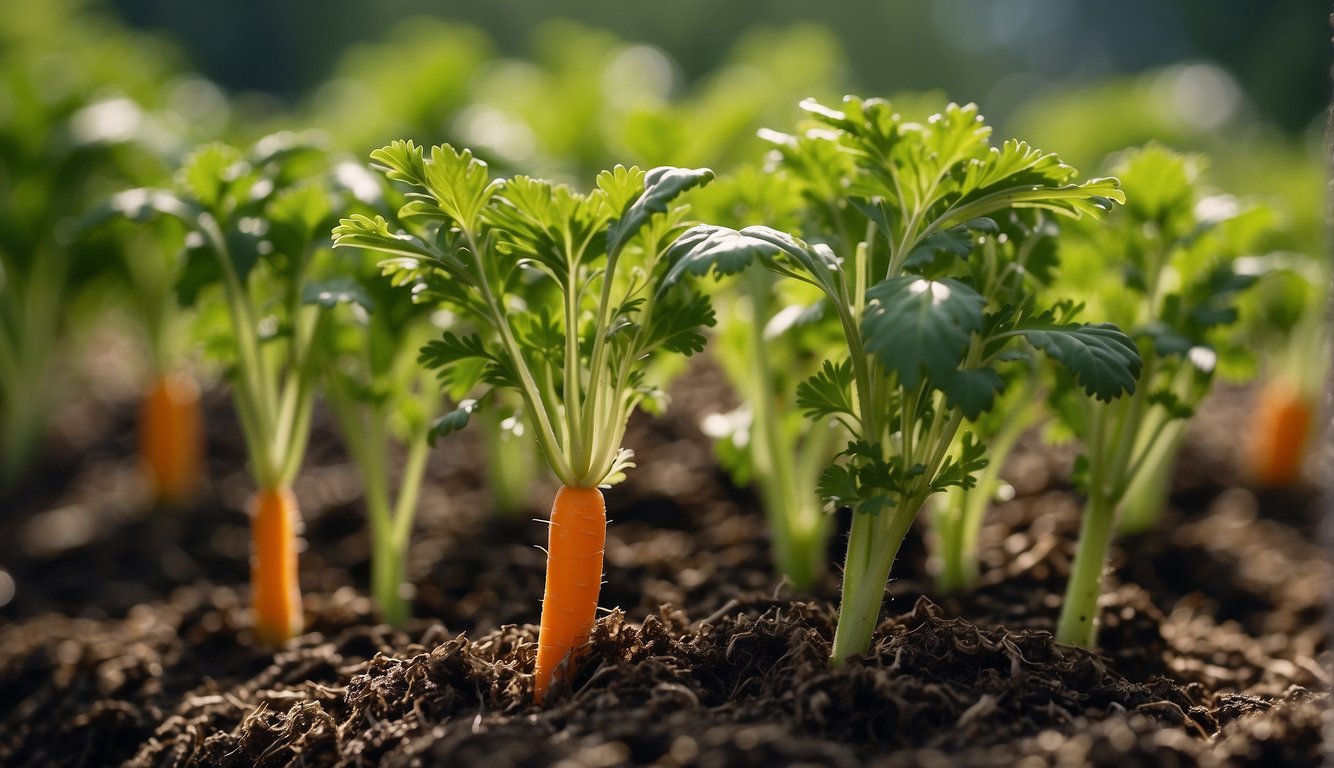Growing carrots from tops is a fun and easy activity for gardeners of all ages and skill levels. All you need is a carrot with its top intact and a bit of patience. With the right care, you can watch your carrot tops grow into beautiful, leafy plants. They will add a touch of green to any windowsill or garden.
Carrot tops are the green, leafy part of the carrot that is often discarded when preparing the vegetable for cooking. However, these tops are not only edible but can also be used to grow new carrots. By placing the carrot top in a shallow dish of water, you can encourage it to sprout new leaves and eventually grow new roots. Once the roots have formed, you can transplant the carrot top into soil and watch it continue to grow into a full-sized carrot.
Regrowing carrots from tops is not only a fun and easy activity, but it’s also a great way to reduce food waste. Instead of throwing away the carrot tops, you can use them to grow new vegetables and enjoy the satisfaction of growing your own food. So why not give it a try and see how easy it is to grow carrots from tops?
Understanding Carrot Biology
Carrots are root vegetables that belong to the Umbelliferae family. There are several varieties of carrots, including Imperator, Chantenay, Danvers, purple, red, round, white, and yellow carrots. Each variety has a unique shape, size, and color.
Carrot Varieties
Imperator carrots, often described as carrots all tops no bottoms due to their long and tapered shape with a pointed tip, are the most common type of carrot found in grocery stores. Chantenay carrots, in contrast to the Imperator’s carrots all tops no bottoms appearance, are shorter and thicker with a rounded tip. Danvers carrots maintain a similar shape to Chantenay carrots but are larger and boast a longer shelf life.
Purple carrots have a deep purple skin and flesh, while red carrots have a bright red skin and orange flesh. Round carrots are small and spherical, while white carrots have a creamy white skin and flesh. Yellow carrots have a yellow-orange skin and flesh.
Growth Cycle of Carrots
Carrots are biennial plants that produce a taproot in their first year and a flower and foliage in their second year. However, most gardeners grow carrots as annuals by harvesting them in their first year before they flower.
Carrots require a pH of 6.0 to 6.8 and nutrient-rich soil with plenty of organic matter. They should be planted in a sunny location with well-draining soil. Carrots take 70 to 80 days to mature and should be harvested before the temperature drops below freezing.
Nutrient Requirements
Carrots require a balanced supply of nutrients, including nitrogen, phosphorus, and potassium. Nitrogen is necessary for foliage growth, while phosphorus is essential for root development. Potassium helps to increase the quality and yield of the crop.
To ensure that your carrots receive the necessary nutrients, you can fertilize the soil before planting. A general-purpose fertilizer with a 10-10-10 or 5-10-10 ratio is recommended. However, be careful not to over-fertilize, as this can damage the roots and reduce the quality of the crop.
In conclusion, understanding the biology of carrots is essential for growing a healthy and abundant crop. By selecting the right carrot variety, providing the proper growing conditions, and ensuring that your carrots receive the necessary nutrients, you can grow delicious and nutritious carrots from tops.
Preparation for Planting

To grow carrots from tops, there are a few things to consider before planting. In this section, I will discuss the preparation needed for planting carrot tops, including selecting carrot tops, soil and potting, and choosing containers.
Selecting Carrot Tops
When selecting carrot tops, it is important to choose healthy ones. Look for carrot tops that are fresh and green, with no signs of wilting or yellowing. Carrots that are grown organically are best, as they are free from pesticides and other harmful chemicals. You can also use the tops of carrots that you have already eaten, just make sure they are healthy.
Soil and Potting
The soil you use for planting carrot tops should be well-draining and have a pH range of 6.0 to 6.8. You can use a potting mix that is specifically designed for container gardening, or you can make your own by mixing equal parts of peat moss, vermiculite, and perlite. This will ensure that the soil is light and airy, allowing the carrot tops to grow properly.
Choosing Containers
When choosing containers for planting carrot tops, make sure they have drainage holes to prevent water from accumulating and causing root rot. You can use any type of container, such as plastic pots, ceramic pots, or even recycled containers. Just make sure they are deep enough to accommodate the length of the carrot tops.
In summary, to prepare for planting carrot tops, you need to select healthy carrot tops, use well-draining soil with a pH range of 6.0 to 6.8, and choose containers with drainage holes. By following these steps, you can ensure that your carrot tops will grow into healthy and delicious carrots.
Planting Process

How to Plant Carrot Tops
Growing carrots from carrot tops is a fun and easy way to regrow this delicious vegetable. Here are the step-by-step instructions to plant carrot tops:
- Cut off the top of the carrot, leaving about an inch of stem attached.
- Place the carrot top in a shallow dish filled with water, cut side down. Make sure that the water level is just below the cut end of the carrot top.
- Change the water every other day to prevent it from becoming stagnant.
- After about two weeks, you should see small roots growing from the bottom of the carrot top.
- Once the roots are about an inch long, you can transplant the carrot top into soil.
Optimal Spacing and Depth
When planting your carrot tops in soil, it is important to space them out properly and plant them at the right depth. Here are some guidelines to follow:
- Space your carrot tops about two inches apart from each other.
- Plant the carrot tops about 1/4 inch deep in the soil.
- Make sure that the soil is loose and well-draining to allow the roots to grow properly.
- Water the soil regularly to keep it moist but not waterlogged.
By following these simple steps, you can easily grow carrot tops into healthy seedlings that will eventually produce delicious carrots.
Caring for Growing Carrots
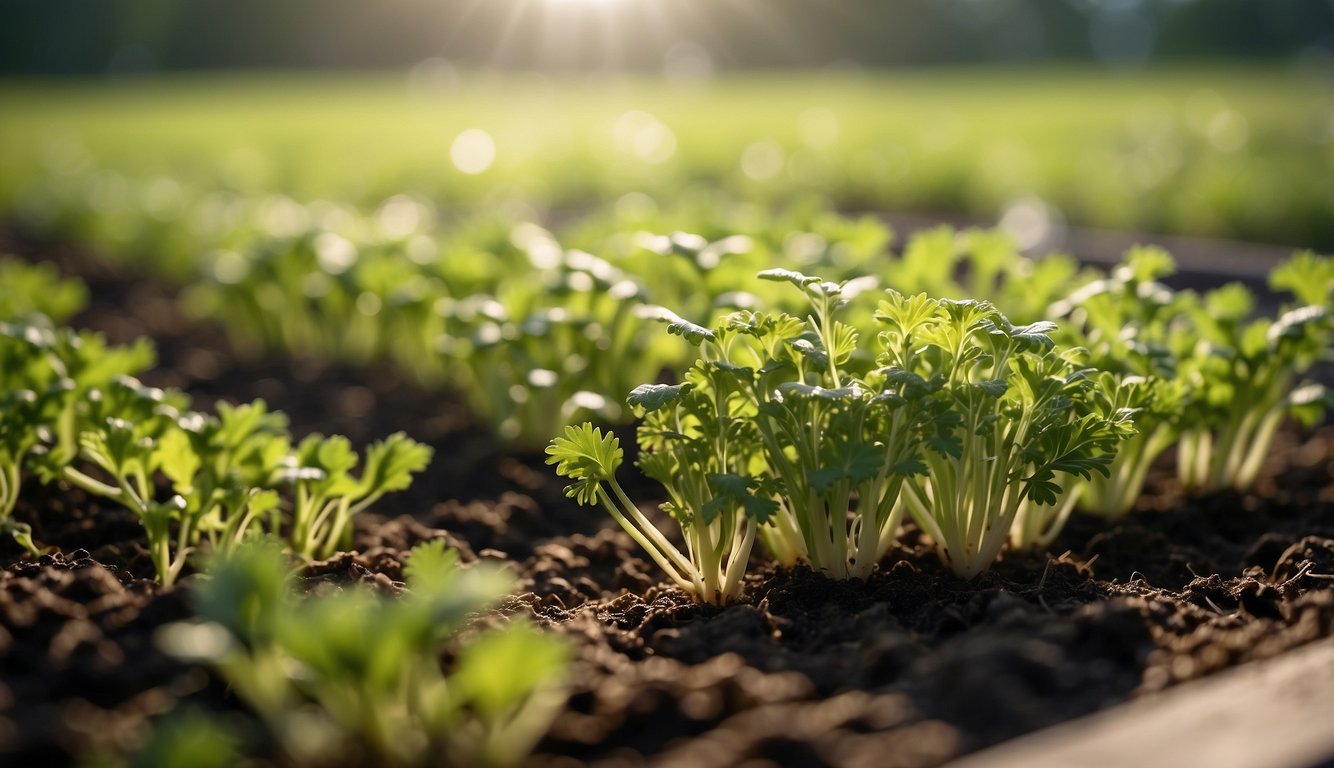
Growing carrots from carrot tops can be a fun and rewarding experience. However, it is important to care for your carrots properly to ensure a healthy and bountiful harvest. Here are some tips on how to care for your growing carrots.
Watering Techniques
Carrots require consistent moisture to grow properly. It is important to water your carrots regularly, but not too much. Overwatering can cause the roots to rot and the foliage to become yellow and wilted. A good rule of thumb is to water your carrots deeply once a week, making sure the soil is moist to a depth of at least 6 inches.
Another watering technique is to use damp newspaper to help keep the soil moist. Simply lay a layer of damp newspaper over the soil and then cover it with a layer of mulch. The newspaper will help to retain moisture in the soil, while the mulch will help to prevent weeds from growing.
Weed and Pest Control – Grow Carrots from Tops
Weeds can be a major problem when growing carrots. They compete with the carrots for nutrients and water, and can even attract pests. To prevent weeds from growing, it is important to keep the soil around your carrots free of debris and to mulch the soil.
Carrot rust flies and nematodes can also be a problem when growing carrots. These pests can cause damage to the roots and foliage, and can even kill the plant. To prevent these pests from attacking your carrots, it is important to rotate your crops and to plant carrots in soil that has not been used to grow carrots in the past.
Fertilizing and Mulching
Fertilizing your carrots is important to ensure they have the nutrients they need to grow properly. A good fertilizer for carrots is one that is high in phosphorus and potassium. It is important to fertilize your carrots at the right time, which is usually four to six weeks after planting.
Mulching is also important when growing carrots. Mulch helps to retain moisture in the soil, prevent weeds from growing, and regulate soil temperature. A good mulch for carrots is one that is organic, such as straw or leaves.
By following these tips, you can ensure that your growing carrots are healthy and bountiful. Remember to water your carrots regularly, control weeds and pests, and fertilize and mulch your soil. With a little care and attention, you can enjoy a delicious harvest of fresh, homegrown carrots.
Environmental Factors

When it comes to growing carrots from tops, there are a number of environmental factors to consider. Two key factors to keep in mind are temperature and weather, as well as sunlight and placement.
Temperature and Weather – Grow Carrots from Tops
Carrots grow best in cool weather, with temperatures between 60 and 65 degrees Fahrenheit being ideal. If temperatures get too hot, the carrots may become tough and woody. On the other hand, if temperatures get too cold, the carrots may not grow at all.
If you are growing carrots from tops in a raised bed or vegetable garden, it is important to keep an eye on the weather forecast. In particularly cold weather, you may need to cover the plants with a frost blanket to protect them from frost damage.
Sunlight and Placement
Carrots need plenty of sunlight to grow, but they can also be sensitive to direct sunlight. If you are growing carrots from tops in a sunny window, be sure to place them in a location where they will receive indirect sunlight. Direct sunlight can cause the plants to wilt or dry out.
If you are growing carrots from tops in a vegetable garden, choose a sunny location that receives at least six hours of sunlight per day. This will ensure that the plants have enough light to carry out photosynthesis and grow properly.
By paying attention to temperature and weather, as well as sunlight and placement, you can ensure that your carrots grow strong and healthy. With a little care and attention, you can enjoy a bountiful harvest of delicious, homegrown carrots.
Harvesting and Regrowth – Grow Carrots from Tops
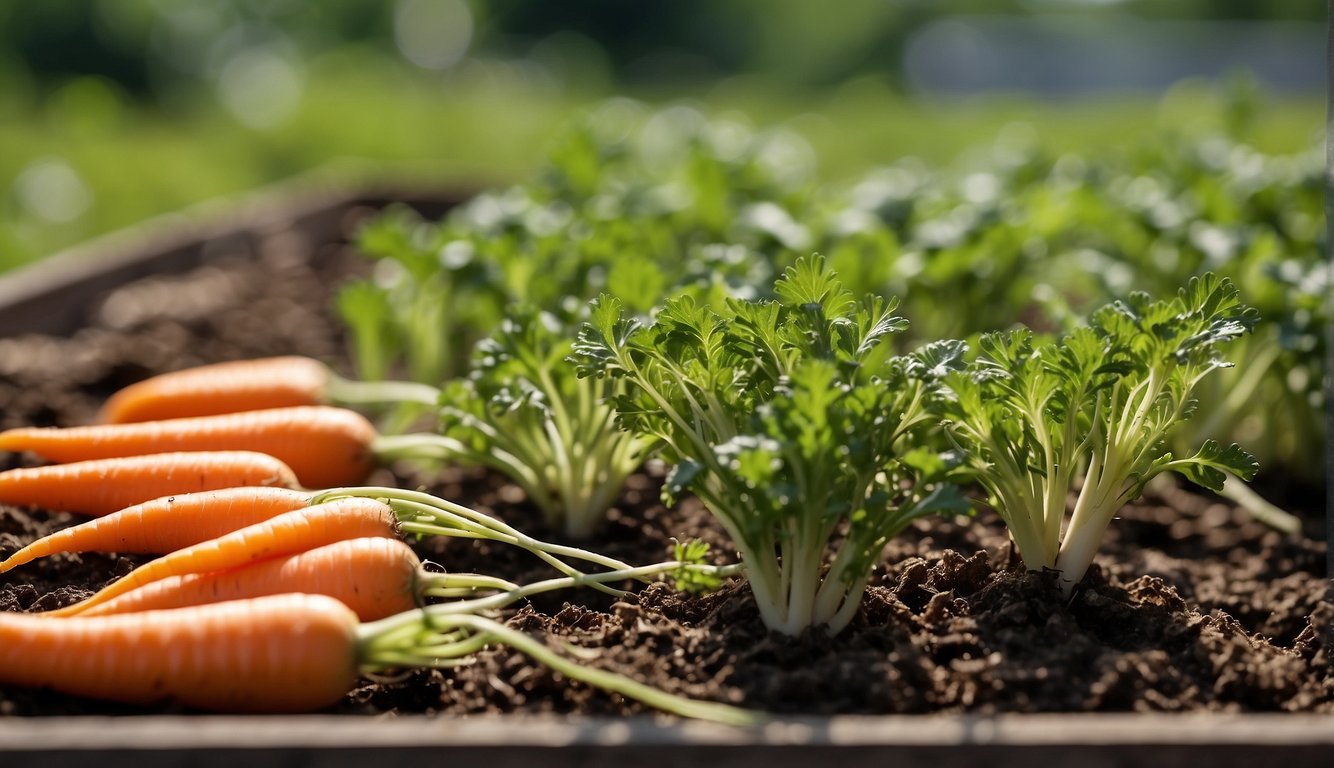
When and How to Harvest – Grow Carrots from Tops
When it comes to harvesting carrots, it’s important to wait until they have fully matured. This usually takes around 60-80 days, depending on the variety of carrot you are growing. You can tell when they are ready by gently pulling one out of the ground and checking the size and color. If they are the size you want and have a deep orange color, they are ready to be harvested.
To harvest your carrots, gently loosen the soil around them with a garden fork or trowel. Then, grasp the greens at the top of the carrot and pull gently but firmly. The carrot should come out of the ground easily. Be sure to remove any excess soil from the carrot before storing.
Regrowing Carrots
Did you know that you can actually regrow carrots from the tops? While the carrot itself cannot be regrown, the greens can be used to grow new roots. To do this, simply cut the greens off the top of the carrot, leaving about an inch of the stem attached. Place the greens in a shallow dish of water, making sure that the bottom of the stem is submerged.
Change the water every few days to keep it fresh and prevent bacteria from growing. Within a week or two, you should start to see new roots growing from the bottom of the stem. Once the roots are a few inches long, you can transplant the greens into a pot or directly into the ground. Be sure to keep the soil moist and give the plants plenty of sunlight.
Not only is regrowing carrots a fun and easy project, but it’s also a great way to reduce food waste. Instead of throwing away the carrot greens, you can use them to grow new carrots and enjoy a fresh, homegrown harvest.
Additional Tips and Uses – Grow Carrots from Tops
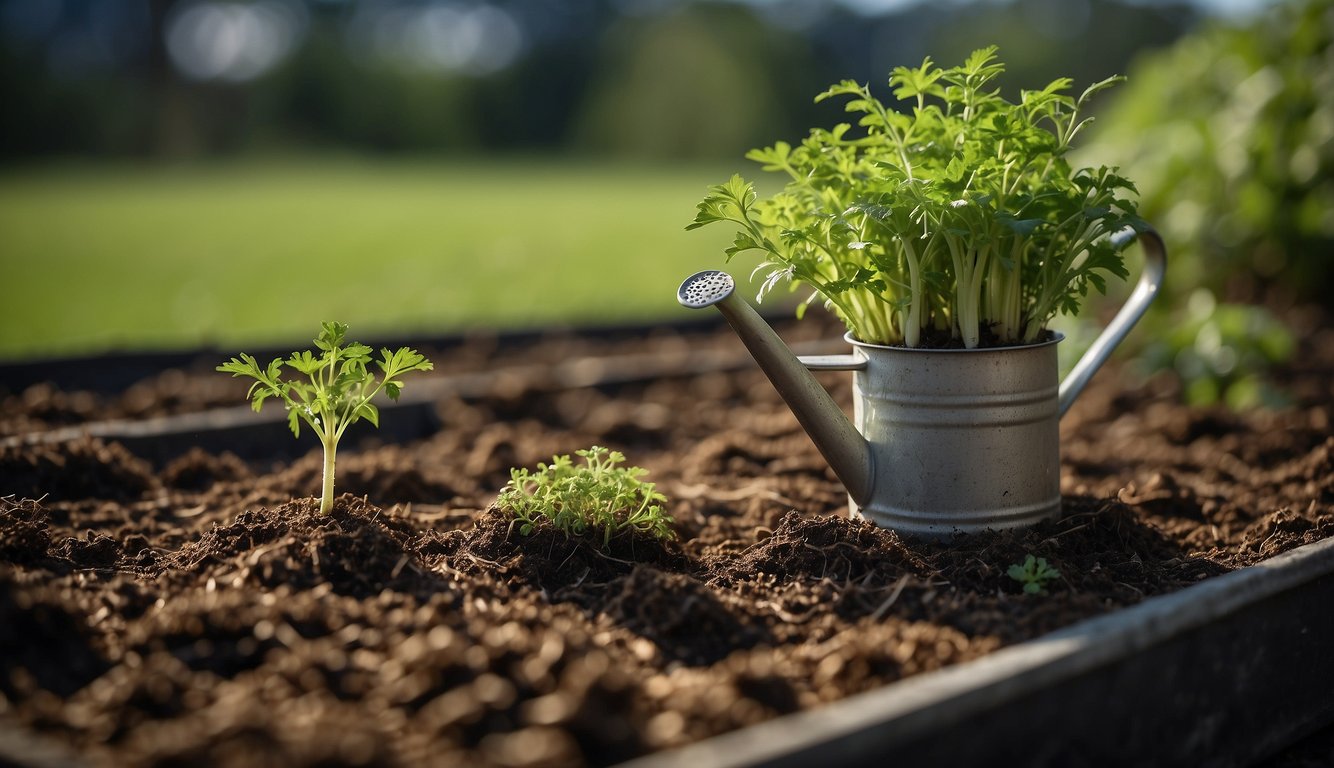
Storing and Using Carrots – Grow Carrots from Tops
Once you have grown carrots from tops, it’s important to know how to store and use them properly. Store carrots in a cool, dry place, such as a refrigerator, to keep them fresh for longer. Carrots can last up to several weeks when stored properly. You can also freeze carrots for later use. Simply blanch them in boiling water for a few minutes, then plunge them into ice water to stop the cooking process. After that, you can store them in an airtight container in the freezer for up to 12 months.
Carrots are a versatile food that can be used in a variety of dishes. They can be eaten raw, cooked, or roasted. They add flavor and nutrition to soups, stews, and casseroles. Carrots are also a great addition to salads, sandwiches, and wraps. They can be grated or shredded to make coleslaw or carrot cake. The possibilities are endless!
Educational Activities with Kids
Growing carrots from tops can be a fun and educational activity for kids. It teaches them about the importance of reducing food waste and composting. Kids can learn about the different parts of a plant and how they grow. They can also learn about the nutritional value of food and how it affects their bodies.
One fun activity for kids is to create a carrot top garden. Simply place carrot tops in a shallow dish of water and watch them grow. Kids can observe the growth process and learn about the different stages of plant development. They can also decorate the dish with stickers or paint to make it more fun.
Another activity is to make carrot top art. Kids can use the tops to make prints or stamps. Simply dip the tops in paint and press them onto paper. They can also use the tops to make a collage or a 3D sculpture. This activity encourages creativity and imagination.
In conclusion, growing carrots from tops is a simple and fun way to reduce food waste and teach kids about the importance of composting and healthy eating. With a little bit of patience and care, you can grow your own delicious and nutritious carrots.
Companion Planting and Crop Rotation – Grow Carrots from Tops
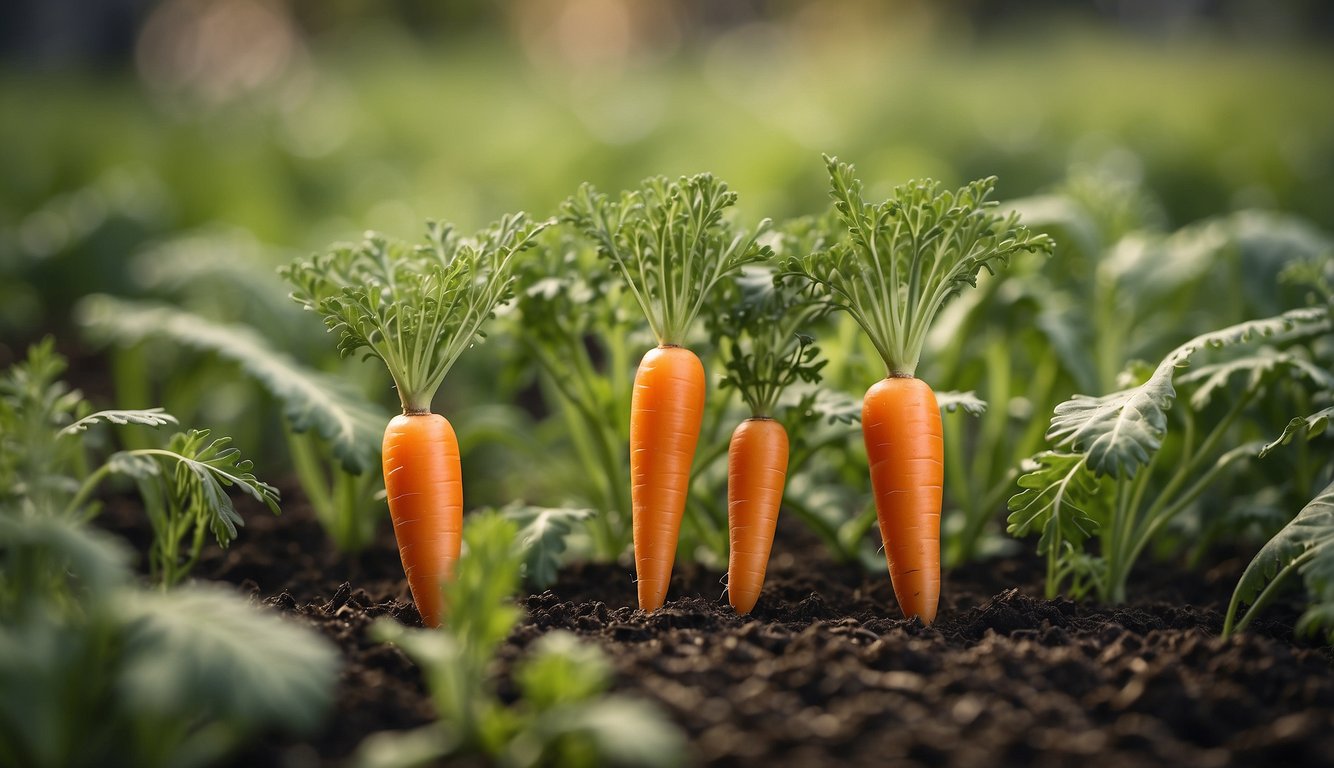
As I grow carrots from tops, I have found that companion planting and crop rotation can play a vital role in the health and productivity of my garden. Companion planting is the practice of growing different plants together that benefit each other in some way. Crop rotation, on the other hand, involves changing the location of crops each year to prevent soil-borne diseases and pests from building up.
Beneficial Companion Plants – Grow Carrots from Tops
When it comes to companion planting, there are several vegetables that make great companions for carrots. For instance, lettuce and parsley are great companion plants for carrots as they help to repel pests and attract beneficial insects such as ladybugs and lacewings. Tomatoes and carrots are also a classic combination that enhances the flavor of their neighboring crops. Tomatoes can also act as natural pest repellents, making them a great companion for carrots.
Leeks, dill, and celery are other vegetables that can make great companions for carrots. Leeks and carrots are both members of the same family, and planting them together can help to deter pests that target members of the Allium family. Dill, on the other hand, attracts beneficial insects such as wasps and ladybugs that feed on aphids and other pests. Celery is also a great companion for carrots as it can help to repel carrot flies.
Avoiding Unfavorable Combinations
While there are several vegetables that make great companions for carrots, there are also some combinations to avoid. For example, parsnips and carrots should not be planted together as they can cross-pollinate and produce inferior crops. Additionally, planting carrots and members of the Brassica family (such as broccoli and cabbage) together can lead to stunted growth and poor yields.
In conclusion, companion planting and crop rotation are essential practices for any gardener looking to grow healthy and productive crops. By planting carrots alongside beneficial companion plants such as lettuce, parsley, and tomatoes, and avoiding unfavorable combinations such as parsnips and members of the Brassica family, you can ensure that your garden thrives year after year.
Grow Carrots from Tops
Today, we’re going to explore the magic of growing carrots from tops. Yes, you read that right!
Firstly, don’t toss those carrot tops! They’re not just for the compost heap. They can sprout new life, and it’s as easy as pie!
Here’s the deal. Take your carrot top, leave about an inch of the carrot attached, and place it in a shallow dish of water. Voila! You’ve started your carrot top garden!
Now, here’s the fun part. In a few days, you’ll see tiny green shoots sprouting from the top. It’s like watching a mini forest grow!
And the best part? You can plant this sprouted top in soil, and it will grow into a lovely leafy plant. It won’t grow a new carrot, but it’s a beautiful addition to your garden!
So, next time you’re munching on a carrot, remember to save the top. Your garden will thank you!
For more gardening tips, do visit the website theherbprof.com. Keep it green, folks!
References – Grow Carrots from Tops
Little Herb Encyclopedia, by Jack Ritchason; N.D., Woodland Publishing Incorporated, 1995
The Ultimate Healing System, Course Manual, Copyright 1985, Don Lepore
Planetary Herbology, Michael Tierra, C.A., N.D., Lotus Press, 1988
Handbook of Medicinal Herbs, by James A. Duke, Pub. CRP Second Edition 2007
The Complete Medicinal Herbal, by Penelope Ody, Published by Dorling Kindersley
Check the Following Articles!
Fruit Bushes That Grow in Shade: Guide to Shade-Tolerant
Do Rubber Trees Like to Be Root Bound?
Tomato Water Wilt: Causes and Solutions
Frequently Asked Questions – Grow Carrots from Tops
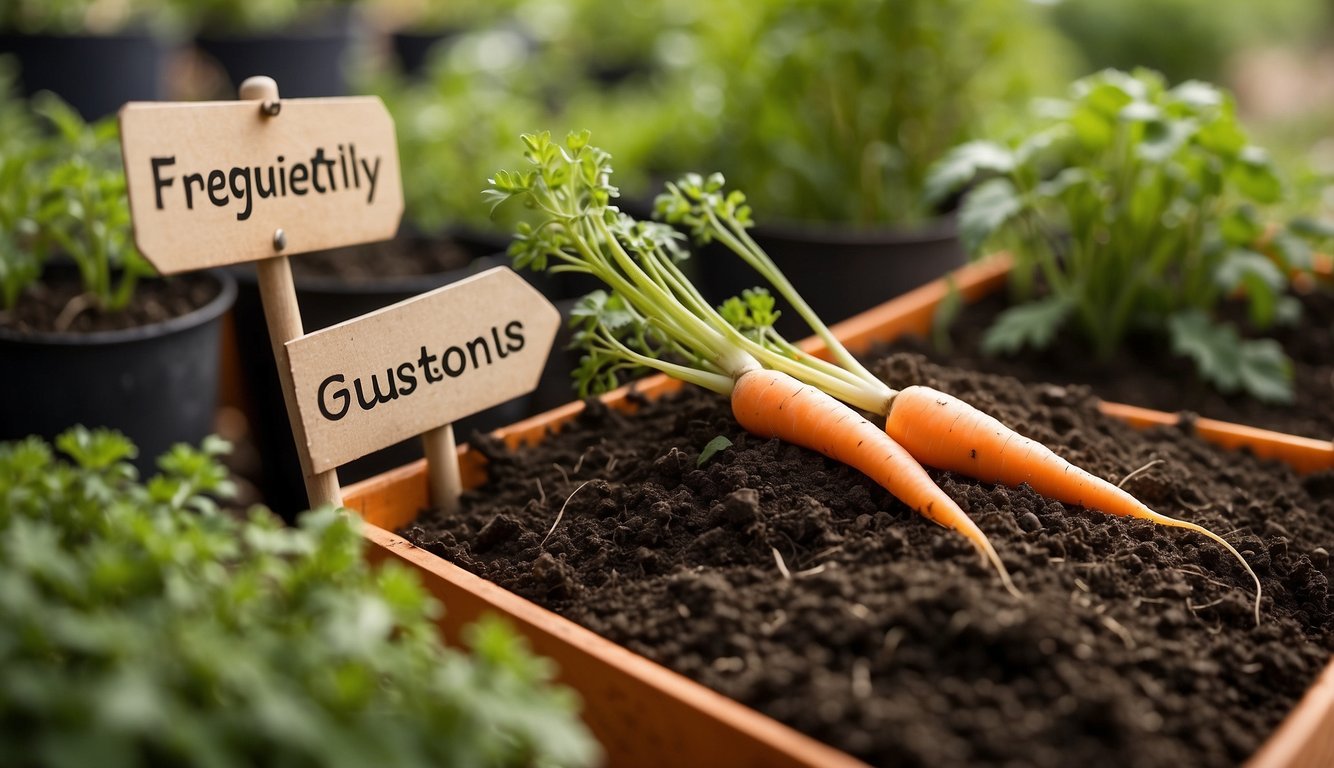
What is the process for cultivating carrots using only the tops?
To grow carrots from tops, we need to take a carrot stump or scraps and cut off 2.5 cm of the carrot with a sharp knife and cutting board. Then, we need to place the carrot top in a shallow dish with water, ensuring that the water level is just below the top of the carrot. We need to change the water every day to prevent rotting. After a few days, we will see small roots emerging from the carrot top. Once we see the roots, we can transfer the top to a pot with soil, keeping the top half exposed. We need to water the soil regularly, and the new carrot should sprout in a few weeks.
What is the expected timeframe for carrot tops to develop into full plants?
The time it takes for carrot tops to develop into full plants depends on various factors such as the temperature, humidity, and soil conditions. On average, it takes around 2-4 weeks for the carrot top to sprout and another 2-3 months for the plant to mature and produce edible carrots.
Is it possible to propagate carrot tops in water, and how is it done?
Yes, it is possible to propagate carrot tops in water. We need to place the carrot top in a shallow dish with water, ensuring that the water level is just below the top of the carrot. We need to change the water every day to prevent rotting. After a few days, we will see small roots emerging from the carrot top. Once we see the roots, we can transfer the top to a pot with soil, keeping the top half exposed.
Can you obtain seeds from carrot tops, and if so, how long does it take?
No, we cannot obtain seeds from carrot tops. Carrot tops can produce seeds after flowering, but it takes two years for the plant to mature and produce seeds. Therefore, it is not practical to obtain seeds from carrot tops.
What are the necessary conditions for growing carrot tops in soil?
To grow carrot tops in soil, we need to ensure that the soil is well-drained, loose, and fertile. We need to plant the carrot top half-exposed in the soil and water regularly. The ideal temperature for growing carrot tops is between 60-70°F (15-21°C), and they need at least 6 hours of sunlight per day.
How tall can we expect the foliage of carrot tops to grow?
The foliage of carrot tops can grow up to 12 inches (30 cm) tall. However, the height may vary depending on the growing conditions and the variety of the carrot.
